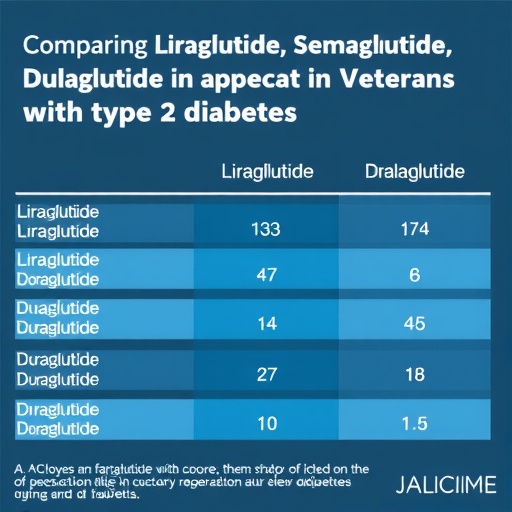A recent comparative effectiveness study published in JAMA Network Open has provided new insights into the cardiovascular and renal outcomes associated with three widely prescribed glucagon-like peptide-1 receptor agonists (GLP-1 RAs)—liraglutide, semaglutide, and dulaglutide—among veterans with type 2 diabetes. This observational analysis, while not a randomized controlled trial, employed rigorous methodological approaches to parse out differences in clinical outcomes, revealing no significant differences in risks for kidney and cardiovascular events among initiators of these medications. These findings prompt a reevaluation of the current therapeutic hierarchy and call for randomized head-to-head trials to validate the comparative safety and efficacy of these agents in broader diabetic populations.
The therapeutic landscape for type 2 diabetes increasingly emphasizes cardiovascular and renal risk reduction, recognizing that glycemic control alone is insufficient to prevent the morbid complications of the disease. GLP-1 RAs have emerged as pivotal agents, with various large-scale randomized trials supporting their capacity to reduce major adverse cardiovascular events (MACE) and slow progression of diabetic nephropathy. Liraglutide, semaglutide, and dulaglutide, each with distinct molecular profiles and pharmacokinetics, have demonstrated individually robust efficacy, but direct comparative data have been limited, necessitating investigations such as this to inform clinical decision-making.
This particular study leveraged the Veterans Health Administration database, enabling access to extensive longitudinal patient data. The analysis incorporated advanced statistical techniques designed to emulate randomized treatment comparisons through careful adjustment of confounding variables. The veteran population window, characterized by a predominantly male cohort with substantial cardiovascular disease burden, offers a real-world context that complements the more selective patient populations enrolled in traditional randomized controlled trials.
Intriguingly, after controlling for baseline patient characteristics and co-medications, the risk of cardiovascular endpoints such as myocardial infarction, stroke, and heart failure hospitalization did not differ significantly between patients initiating liraglutide versus semaglutide or dulaglutide. Similarly, renal outcomes, including progression to end-stage kidney disease or significant decline in estimated glomerular filtration rate, were comparable across these drug initiators. These findings reinforce the clinical equipoise among these particular GLP-1 RA agents in mitigating diabetes-related cardiorenal complications.
While randomized clinical trials represent the gold standard for determining causality between interventions and outcomes, the logistical and ethical complexities inherent in such trials, especially comparing already approved medications, have limited direct comparisons. Observational comparative effectiveness studies like this one employ sophisticated analytic methods such as propensity score matching and inverse probability weighting to mimic randomization, which although cannot fully eliminate unmeasured confounding, provide valuable and timely evidence with pragmatic relevance.
The heterogeneity in molecule structure between liraglutide, semaglutide, and dulaglutide—ranging from differences in receptor binding affinity to dosing frequency—may theoretically translate into variable clinical effects. However, the study’s findings suggest that these pharmacological differences do not tangibly alter medium-term cardiorenal outcomes in practice. This equivalency may provide clinicians with latitude to tailor treatment based on patient preferences, tolerability, cost, and route of administration without compromising efficacy.
Moreover, the findings have implications for health system formulary decisions, potentially alleviating pressure to favor any one particular agent purely based on perceived superiority in cardiovascular or renal risk mitigation. In resource-constrained environments, such flexibility can enable broader access to GLP-1 RAs, accelerating uptake of these beneficial therapies in populations that historically experience high rates of diabetic complications.
Nonetheless, the authors prudently highlight the need for prospective randomized head-to-head trials to definitively substantiate this apparent parity in clinical effectiveness. Such trials would provide more granular insight into long-term safety, differential effects in diverse demographic and clinical subgroups, and potential mechanistic distinctions that could inform personalized medicine approaches in diabetes care.
The study also underscores the critical importance of studying real-world outcomes beyond glycemic indices alone. As diabetes treatment evolves, cardiovascular and renal protection have shifted from being ancillary benefits to central therapeutic targets. A growing consensus posits that optimizing drug selection on these clinical endpoints, supported by robust comparative effectiveness data, constitutes best practice in the evolving paradigm of holistic diabetes management.
It is essential to note that this study focused on a predominantly male veteran population with substantial comorbidities, which may limit generalizability to the broader, more diverse patient populations. Further research in women, different ethnic groups, and patients with varying disease severity is warranted to confirm these results and enhance inclusivity.
In conclusion, this comprehensive comparative study provides compelling evidence that liraglutide, semaglutide, and dulaglutide demonstrate similar effectiveness in reducing cardiovascular and kidney risks in veterans with type 2 diabetes. Clinicians can consider these agents as broadly equivalent options pending further head-to-head trials. Such data empower informed therapeutic choices, balancing efficacy with patient-centered factors, and ultimately improving outcomes in a population burdened by multi-system diabetic complications.
The evolution of diabetes pharmacotherapy demands continuous scrutiny of existing treatments to refine strategies towards precision medicine. Studies like this bridge the gap between randomized trial evidence and real-world application, offering nuanced perspectives that can reshape clinical guidelines and optimize patient care.
Subject of Research: Comparative effectiveness of glucagon-like peptide-1 receptor agonists on cardiovascular and renal outcomes in patients with type 2 diabetes.
Article Title: Comparative Cardiovascular and Renal Outcomes of Liraglutide, Semaglutide, and Dulaglutide Initiators Among Veterans With Diabetes.
News Publication Date: Information not provided.
Web References: Not provided.
References: (doi:10.1001/jamanetworkopen.2025.37297)
Image Credits: Not applicable.
Keywords: Type 2 diabetes, cardiovascular disorders, kidney, medications, risk factors, randomization, diabetes.




